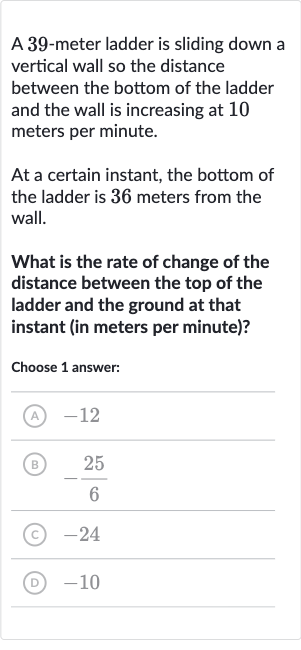AI tutor
Welcome to Bytelearn!
Let’s check out your problem:

A -meter ladder is sliding down a vertical wall so the distance between the bottom of the ladder and the wall is increasing at meters per minute.At a certain instant, the bottom of the ladder is meters from the wall.What is the rate of change of the distance between the top of the ladder and the ground at that instant (in meters per minute)?Choose answer:(A) (B) (C) (D)
Full solution
Q. A -meter ladder is sliding down a vertical wall so the distance between the bottom of the ladder and the wall is increasing at meters per minute.At a certain instant, the bottom of the ladder is meters from the wall.What is the rate of change of the distance between the top of the ladder and the ground at that instant (in meters per minute)?Choose answer:(A) (B) (C) (D)
- Triangle Description: We're dealing with a right triangle where the ladder is the hypotenuse, the distance from the wall is one leg, and the height of the ladder above the ground is the other leg.
- Variable Assignment: Let's call the distance from the wall to the bottom of the ladder , and the height of the ladder above the ground . We know that is changing at meters per minute.
- Pythagoras' Theorem: Using Pythagoras' theorem, we have , since the ladder is meters long.
- Differentiation: Differentiate both sides of the equation with respect to time to find the rate of change of with respect to time. So we get .
- Initial Values: We know meters per minute (since is increasing at meters per minute), and at the instant we're considering, meters.
- Calculate : We need to find at the instant meters. Using Pythagoras' theorem again, we have .
- Substitute Values: Calculate .
- Solve for : Take the square root of to find . So meters.
- Isolate : Now we can substitute , , and into the differentiated equation: .
- Final Result: Solve for : .
- Final Result: Solve for : .Isolate : .
- Final Result: Solve for : .Isolate : .Divide both sides by to find : meters per minute.
More problems from Calculate unit rates with fractions
QuestionGet tutor help
QuestionGet tutor help
QuestionGet tutor help
QuestionGet tutor help
QuestionGet tutor help
QuestionGet tutor help
QuestionGet tutor help
QuestionGet tutor help
QuestionGet tutor help
